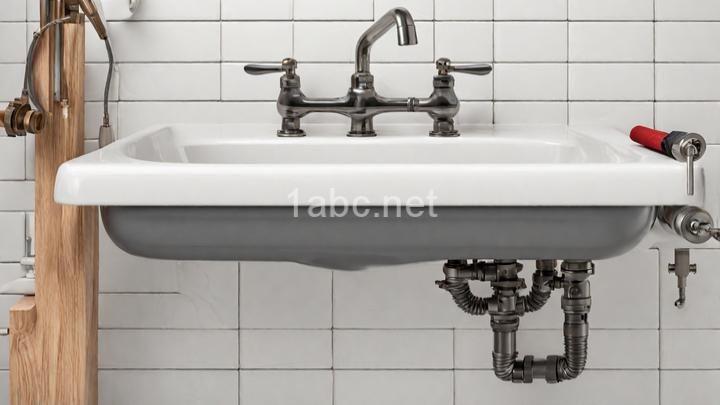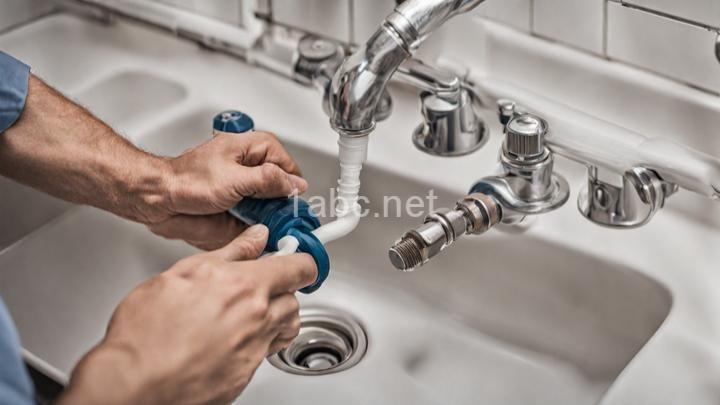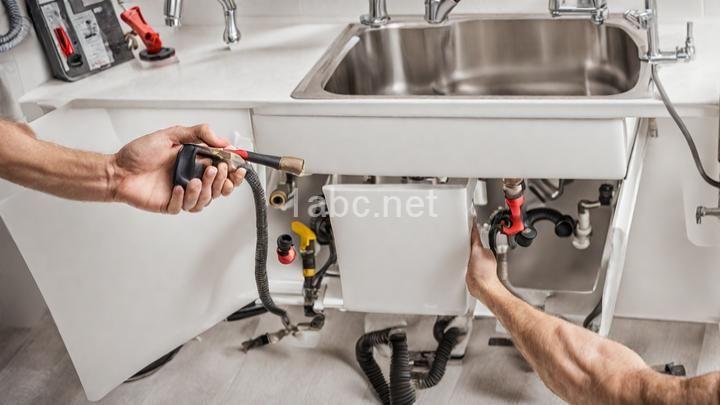The Ultimate Guide to DIY Plumbing Repairs for Homeowners

Introduction:
Welcome homeowners! In this ultimate guide, we will equip you with the knowledge and skills to tackle common plumbing repairs on your own. No need to panic when faced with a leaky faucet or a clogged drain. We've got you covered!
I. Understanding the Basics of Plumbing Systems:
Plumbing systems may seem daunting at first, but once you understand the basics, you'll be able to handle most repairs with ease. A plumbing system consists of water supply lines, drainage pipes, and fixtures. The water supply lines bring fresh water into your home, while the drainage pipes remove wastewater. Fixtures, such as faucets, toilets, and showers, are the points where water is used.
It's crucial to familiarize yourself with your home's plumbing layout and locate shut-off valves. Knowing where the main shut-off valve is can save you from a potential disaster in case of a major leak or burst pipe. Additionally, understanding the layout of your plumbing system will help you troubleshoot issues more effectively.
II. Essential Tools Every Homeowner Should Have:
To successfully tackle DIY plumbing repairs, it's important to have the right tools at your disposal. Here are some essential tools every homeowner should have in their toolbox:
-
Pliers: Pliers come in various types, such as slip-joint pliers and adjustable wrench pliers. They are versatile and useful for tasks like tightening or loosening connections.
-
Wrenches: Adjustable wrenches and pipe wrenches are essential for tightening or loosening nuts and bolts. They provide a strong grip and make it easier to work with various sizes of pipes and fittings.
-
Pipe cutters: When you need to replace a section of pipe, a pipe cutter will help you make clean and precise cuts. This tool is especially handy when working with copper or plastic pipes.
-
Plungers: A plunger is a must-have for unclogging drains. There are different types of plungers for sinks, toilets, and showers. Make sure to use the appropriate plunger for the specific fixture.
Each tool has its own specific purpose and functionality. Understanding how to use them properly will make your DIY plumbing repairs much easier and more efficient.
III. Dealing with Common Plumbing Problems:
A. Fixing Leaky Faucets:
Leaky faucets are not only annoying but can also waste a significant amount of water if left unattended. To fix a leaky faucet, follow these steps:
-
Identify the type of faucet: There are different types of faucets, including compression, cartridge, and ball faucets. Understanding the type will help you determine the appropriate repair method.
-
Turn off the water supply: Before starting any repair, always turn off the water supply to the affected faucet.
-
Replace faulty parts: Leaks are often caused by worn-out washers, O-rings, or cartridges. Replace these faulty parts with new ones to stop the leak.
B. Unclogging Drains:
Clogged drains are a common plumbing issue that can be easily resolved with the right techniques and tools. Here's how to unclog drains effectively:
-
Use a plunger: For sinks, showers, or bathtubs, a plunger can be highly effective in dislodging clogs. Create a seal around the drain and plunge vigorously to create pressure that will push the clog out.
-
Try a drain snake: If plunging doesn't work, a drain snake can help reach deeper clogs. Insert the snake into the drain and rotate it to break up the clog or pull it out.
-
Preventive measures: To avoid future clogs, be mindful of what goes down your drains. Avoid pouring grease, hair, or large food particles down the sink. Consider using a drain strainer to catch debris.
C. Repairing Running Toilets:
A running toilet not only wastes water but can also be a nuisance. Here's how to fix a running toilet:
-
Adjust the flapper valve: The flapper valve is responsible for sealing the tank and preventing water from continuously flowing into the bowl. Adjust the chain or replace the flapper if it's not sealing properly.
-
Replace the fill valve: If adjusting the flapper doesn't solve the issue, the fill valve might be faulty. Replace the fill valve to stop the continuous flow of water.
D. Handling Burst Pipes or Water Leaks:
Burst pipes or water leaks can cause significant damage if not addressed promptly. Here's what to do in case of a burst pipe emergency:
-
Shut off the water supply: Locate the main shut-off valve and turn it off to stop the flow of water. This will prevent further damage and flooding.
-
Temporarily fix the burst pipe: If you have the necessary materials, you can use a pipe clamp or a rubber patch to temporarily seal the burst pipe until professional help arrives.
IV. Safety Precautions When Working with Plumbing Systems:
When working with plumbing systems, safety should be a top priority. Here are some safety precautions to follow:
-
Wear safety goggles and gloves: Protect your eyes and hands from potential hazards like debris, chemicals, or sharp objects.
-
Ensure proper ventilation: When using drain cleaners or working in enclosed spaces, make sure there is proper ventilation to avoid inhaling harmful fumes.
-
Be cautious of electrical connections: Avoid contact with electrical connections when working on plumbing repairs. If necessary, turn off the power to the affected area.
-
Be mindful of water damage: Place a bucket or towel under the area you're working on to prevent water damage to surrounding areas or floors.
V. Knowing When to Call a Professional:
While DIY plumbing repairs can save you time and money, there are situations where it's best to call a professional plumber. Here are some signs that indicate a more serious plumbing issue:
-
Multiple clogged drains: If you have multiple clogged drains throughout your home, there may be a larger issue in the main sewer line that requires professional attention.
-
Low water pressure: Persistent low water pressure could indicate a problem with your home's plumbing system that requires professional expertise to diagnose and fix.
-
Gas leaks: If you smell gas or suspect a gas leak, evacuate your home immediately and call a professional plumber or your gas company.
Conclusion:
Congratulations, homeowners! You are now armed with the knowledge and confidence to handle most common plumbing issues on your own. Remember, practice makes perfect, so don't be afraid to get your hands dirty. By mastering these DIY plumbing repairs, you'll save time, money, and gain a sense of accomplishment. Happy fixing!
Remember, if you ever need further guidance or have questions along the way, feel free to reach out to us for expert advice. We're here to help!
Stay tuned for more helpful tips and tricks on dorenelashay9177!
FREQUENTLY ASKED QUESTIONS
What is The Ultimate Guide to DIY Plumbing Repairs for Homeowners?
The Ultimate Guide to DIY Plumbing Repairs for Homeowners is a comprehensive resource that aims to empower homeowners with the knowledge and skills needed to tackle common plumbing issues on their own. Whether you're dealing with a leaky faucet, a clogged drain, or a running toilet, this guide has got you covered.With a focus on simplicity and effectiveness, this guide provides step-by-step instructions and tips for a wide range of plumbing repairs. It covers everything from basic tools you'll need to troubleshooting techniques and safety precautions. You'll also find helpful illustrations and diagrams to make the process even easier to understand.
One of the highlights of this guide is its emphasis on prevention. By learning how to properly maintain your plumbing system and identify potential issues early on, you can avoid costly repairs down the line. From checking for leaks to maintaining your water heater, this guide offers practical advice to keep your plumbing in top shape.
In addition to the practical aspects, The Ultimate Guide to DIY Plumbing Repairs for Homeowners also addresses common concerns and questions that homeowners may have. It provides clear explanations of plumbing terminology and concepts, ensuring that even those with little to no plumbing knowledge can follow along.
While this guide is a valuable resource for homeowners, it's important to note that some plumbing repairs are best left to the professionals. If you encounter a complex issue or feel unsure about your abilities, it's always wise to call a licensed plumber. Safety should always be a top priority.
Overall, The Ultimate Guide to DIY Plumbing Repairs for Homeowners is an indispensable tool for anyone looking to take control of their own plumbing repairs. With its user-friendly approach and comprehensive coverage, it's a must-have for every homeowner's toolkit.
Who is this guide intended for?
This guide is intended for anyone who is interested in learning more about [topic]. Whether you're a beginner looking to get started or someone with more experience seeking to deepen your knowledge, this guide provides valuable information and insights. It is designed to be accessible and helpful for individuals of all backgrounds and skill levels. Whether you're a student, a professional, or simply someone with a curiosity for [topic], this guide is here to assist you on your journey.
What topics does this guide cover?
This guide covers a wide range of topics, including but not limited to:
- Effective communication skills
- Time management strategies
- Stress management techniques
- Goal setting and achievement
- Building self-confidence
- Developing healthy habits
- Enhancing productivity
- Overcoming obstacles and setbacks
- Cultivating positive relationships
- Improving decision-making skills
- Maintaining work-life balance
- Nurturing personal growth and development
- Managing emotions and conflicts
- Enhancing creativity
- Developing leadership skills
- Building resilience and adapting to change.These topics aim to provide comprehensive guidance to help you navigate various aspects of your life and empower you to achieve your personal and professional goals.
Is this guide suitable for beginners or is it more advanced?
This guide is suitable for both beginners and those with more advanced knowledge. It provides a comprehensive overview of the topic, starting with the basics and gradually progressing to more advanced concepts. Whether you're just starting out or looking to expand your existing knowledge, this guide has you covered.

